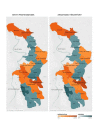Role of community engagement in maternal health in rural Pakistan: Findings from the CLIP randomized trial
- PMID: 34326995
- PMCID: PMC8285765
- DOI: 10.7189/jogh.11.04045
Role of community engagement in maternal health in rural Pakistan: Findings from the CLIP randomized trial
Abstract
Background: Community-based strategies to promote maternal health can help raise awareness of pregnancy danger signs and preparations for emergencies. The objective of this study was to assess change in birth preparedness and complication readiness (BPCR) and pregnant women's knowledge about pre-eclampsia as part of community engagement (CE) activities in rural Pakistan during the Community Level Interventions for Pre-eclampsia (CLIP) Trial.
Methods: The CLIP Trial was a cluster randomized controlled trial that aimed to reduce maternal and perinatal morbidity and mortality using CE strategies alongside mobile health-supported care by community health care providers. CE activities engaged pregnant women at their homes and male stakeholders through village meetings in Hyderabad and Matiari in Sindh, Pakistan. These sessions covered pregnancy complications, particularly pre-eclampsia/eclampsia, BPCR and details of the CLIP intervention package. BPCR was assessed using questions related to transport arrangement, permission for care, emergency funds, and choice of facility birth attendant for delivery during quarterly household surveys. Outcomes were assessed via multilevel logistic regression with adjustment for relevant confounders with effects summarized as odds ratios and 95% confidence intervals.
Results: There were 15 137 home-based CE sessions with pregnant women and families (n = 46 614) and 695 village meetings with male stakeholders (n = 7784) over two years. The composite outcomes for BPCR and pre-eclampsia knowledge did not differ significantly between trial arms. However, CE activities were associated with improved pre-eclampsia knowledge in some areas. Specifically, pregnant women in the intervention clusters were twice as likely to know that seizures could be a complication of pregnancy (odds ratio (OR) = 2.17, 95% confidence interval (CI) = 1.11, 4.23) and 2.5 times more likely to know that high blood pressure is potentially life-threatening during pregnancy (OR = 2.52, 95% CI = 1.31, 4.83) vs control clusters.
Conclusions: The findings suggested that a CE strategy for male and female community stakeholders increased some measures of knowledge regarding complications of pre-eclampsia in low-resource settings. However, the effect of this intervention on long-term health outcomes needs further study.
Trial registration: Clinical Trials.gov - INCT01911494.
Copyright © 2021 by the Journal of Global Health. All rights reserved.
Conflict of interest statement
Competing interests: The authors completed the ICMJE Unified Competing Interest form (available upon request from the corresponding author), and declare no conflicts of interest.
Figures



References
-
- Clinical and Translational Science Awards Consortium, Community Engagement Key Function Committee Task Force on the Principles of Community Engagement. Principles of community engagement: Second edition. Maryland: NIH Publication No. 11-7782; 2011.
Publication types
MeSH terms
Associated data
LinkOut - more resources
Full Text Sources
Medical
